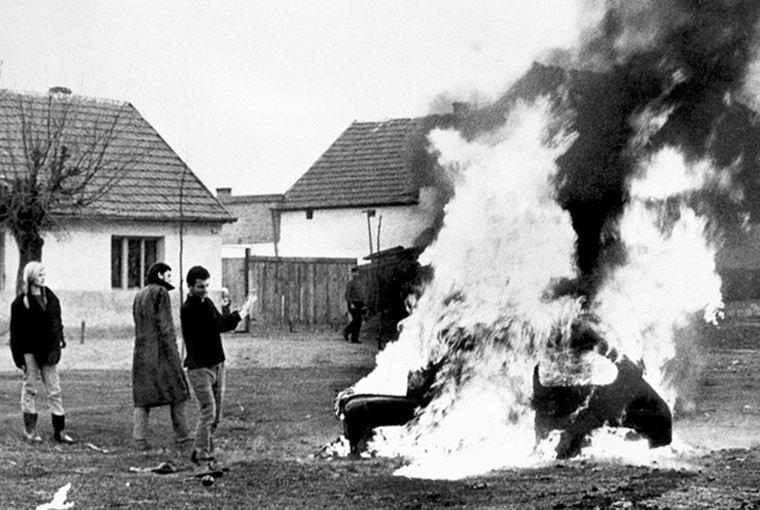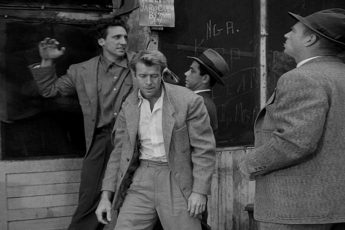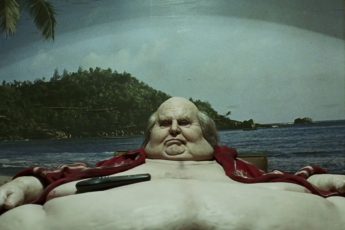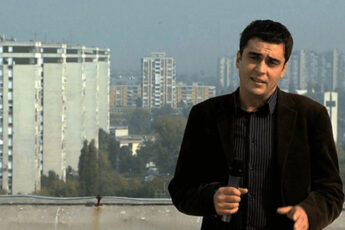
Introduction
Karpo Godina became a renowned filmmaker at first among a specialised film audience during the late 1960s. His work was mostly screened at amateur film festivals and cinema clubs across Yugoslavia, where most future members of ‘New Yugoslav Film’ started their careers.1 Godina made his most influential short films in the early 1970s and it should be borne in mind that his shorts were all taken out of circulation then. These films have recently become accessible on the DVD “Cinema, Happiness: The Short Films of Karpo Godina” (2010) to a larger international audience. In this contribution I concentrate on three shorts from his most creative period: Gratinirani mozak Pupilije Ferkeverk (1970), Zdravi ljudi za razonodu (1971) and O ljubavnim veštinama ili film sa 14441 kvadratom (1972). These ‘early works’ are still shown at various international film festivals, though unfortunately until today there has been no detailed or larger study on the vast body of Godina’s work apart from some reviews, introductions and blogs.2
This contribution revisits and revises some of the commonplace receptions of the above-mentioned early works of Karpo Godina. Most reviewers share a fairly positive evaluation and stress that Godina developed a distinct aesthetical sensibility which is imprinted in his handling of the camera.3 As far as the (political) content of these films go, some reviewers admire Godina’s espousal of countercultural youth values from the late 1960s, while others claim that for a ‘normal viewer’ without sufficient knowledge of the Yugoslav context, many of these early films appear meaningless.4 Many reviewers share a certain assessment of the content of these films that however remains on the surface. From Godina’s playful handling of moving images they derive a political message: his films were highly ironical towards the major Yugoslav institutions (e.g. the army) and criticized the major ideologems (e.g. “brotherhood and unity”) of socialist Yugoslavia. Despite in some way agreeing with these observations, my thesis attempts to move beyond this canonical dichotomy between beautiful aesthetic form and ‘empty’ or ironical political content. I argue that Godina’s short films succeeded in developing certain new aesthetics in then-existing Yugoslav film, and perhaps even started to construct what Rancière terms the “aesthetics of politics”.5 I argue that it is less fruitful to search for some (anti)political core or nominate Godina a political filmmaker delivering social critiques. However, I would suggest a much more fruitful approach that sees his films as becoming political through a certain aesthetic detour. All his early shorts are predominantly interested in developing specific aesthetics that not only subvert both the established genre of documentary and the fictive images of the mainstream production,6 but also the infamous short documentaries/films of the alternative ‘Black Wave’ cinema. The ‘Black Wave’ shorts of the 1960s and early 1970s were predominantly marked as a typical social critique genre that brought to the fore the negative sides of socialist modernisation, such as unemployment, homelessness, precarious types of work, insecurity of youth etc. This criticism was further emphasized by a rough montage, which Pavle Levi would call “raw image”, that carried strong realist and naturalist undertones.7 Contrary to this raw image, Godina’s early works dramatically differ from this ‘realist’ core ; we can conceive of them far more readily as a surrealist current, and also as a renowned dadaist procedure that works against narration, against the immediate assigning of meaning to the moving images. Godina’s method is also experimental in its challenging of the medium (camera) though the involvement of meticulous work with photography, working at the border of photography and film. One could argue that there is something much more ‘bright’, not in terms of optimism and naïveté, but in terms of the playfulness of images, frames, and humoristic tones that make Godina less fitting in the general current of ‘Black Wave’ cinema. On an aesthetic register, his work could be compared to Dušan Makavejev.
Godina’s Gratinating of the Early 1970s
In the 1970s the situation for filmmakers became highly tense to say the least. After the political events of May ’68, student and workers protests, the paranoia surrounding the occupation of Czechoslovakia, the wave of political repression took hold in the Yugoslav sphere, and alternative film production was no exception. Already in the summer of 1969 a harsh politicized campaign against the ‘black’ tendency in ‘New Yugoslav Film’ was launched. Contrary to this pessimistic “misrepresentation” of socialist reality, the socialist authorities started promoting a more optimistic display of socialist society. Film, as the most important art form, became the chief ideological investment of many agencies.8 This was the period when Godina appeared on the film stage, now already as a professional filmmaker.9
Gratinirani mozak Pupilije Ferkeverk was shot in 1970. It is a poetical “journey” of images that takes place in one singular space: Sečovlje’s Soline (Sečovlje’s saltworks).10 McDougall observes that the film opens with “a shot of a body of water, with houses in the distance, as a topless young woman swings on a swing on the right side of the frame. When she reaches the forward part of her swing she is in frame; when she swings backward she is out of frame.”11 We see not only one frame that fixes on one space, but also one simple scene, which is then endlessly edited. Sounds boring, or too minimalistic? Godina’s 10-minute journey will prove this anticipation wrong. Setting himself a very rigorous limitation, namely, a fixation of the camera at one point, Godina succeeds in going far beyond a standstill tableau or photography that would portray the details of the landscape. This self-imposed limitation, which might seem irrational, is actually the most important feature of Godina’s method. What can the camera (still) do if it is limited? This ‘alienation’ of the camera into the static freezing of its real movement resonates strongly with other avant-garde film experiments of that time.12 Far from an irrational impulse or caprice of the filmmaker, this method practices a very philosophical, Hegelian lesson: it is only within certain limits (fixation; confined space) that one can explore the capacities and freedom of camera movement (editing; lenses).
How does Godina un-freeze, dynamize this static camera vision? The movement in the film is primarily propelled by montage, but there are other sources and influences that animate the image of landscape that internally subvert the order of image. One can recognise four main sources that are set into motion and that in a particular manner help ‘narrate’ the story:
Firstly, there is an intervention in this ‘almost’ still-image by human agency, which predominantly assumes the form of woman. The above-described minimal dispositive of the static image is shaken by a young woman who is most often captured using the swing. The swing moves in and out of the frame, making the spectator aware that this ‘outside’ is actually just a swing away and that it constantly threatens to disturb the totality of the image. In other moments she is also absent from the frame, and later on, she is joined by a group of young men, who pose, run, dance, and perform in front of the camera. These movements elude to seductive and sexual rituals and games, wherein the female character takes the central stage.
Secondly, there is a considerable directorial presence through the camera’s take on the landscape. During the film, the viewers can observe multiple changes of the same landscape: the rising levels of water, the changing speed of wind that touches the water surface and makes it travel almost like a river. Aesthetic sensibility is achieved through the use of different colour lenses that intensify the surrealist atmosphere; the environment is displayed in rich colours. There is a strong impression that the camera follows this salt habitat through different seasons – despite the film having actually being shot in a few days.
Thirdly, the camera movement and elusive narrative – as is prominent in the early works of Godina – is strengthened by the music, which intensifies the colours, which also emphasizes the gestures of human agency and thus points to the changing landscape.
And fourthly, there is an occasional editorial and ‘inter-medial’ intervention that radically subverts and interrupts the camera flow described above. The swing within the image is here complemented by another image of a different order. Godina juxtaposes the camera flow with carefully designed image-frames that consist of four squares. Each square has a different colour and different content: one square contains numbers, a second symbols (icons like stars), the third presents the name of the author(s)/actors, and the fourth is a giant letter/rebus, at times turned into a meaningful word, or sentence: such as “Suicide”, “Dictatorship”, “Swallow LSD”… These signifiers do not stand as anchors of a linear narrative, but would be very loosely followed by the performance of the young men that might be more or less arbitrarily associated with the signifier. Godina sharpens the arbitrary relationship between the visual signifier and the signified and attempts to re-create a new filmic language that is not satisfied with a ritualized formula of giving meaning in a linear way. He works with associations, visual stimuli: could these visual interventions be defined as a certain dream work of the camera, Kameratraumdeutung? In what these skilfully designed and playful interventions do succeed is to work as proper Brechtian devices of Verfremdungseffekt and make the audience aware of the fact ceci n’est pas un film. This is not only a landscape; this is not simply a theatre group performing their piece in the water; this is not only a sexual ritual…
And where is then the political dimension of this new aesthetics? Is this not, on the contrary, a very depoliticized, sexualized flow that flirts with a certain tendency in ‘68? At the level of message one could speak of sexual emancipation and free consumption of drugs, however, I believe it is more fruitful to interpret Godina’s film primarily as an aesthetic intervention in existing film production, and secondarily in the question of a new generation. The late 1960s were an open and contested field, where youth was even more “targeted” by the League of Communists and organisations: “We lay the future and our hopes in the youth!” This ideological investment was challenged by the Black Wave directors who with their films introduced a whole series of protagonists that became typical antiheroes. However, Godina refused both poles: he was neither a pro-regime idealizing youth, nor negative, attempting to counter the Party-discourse with a social critique, with a true rebellion (e.g. student protests or antiheroes in Black Wave). With Godina we rather witness a certain disinvestment from the world of politics, a refusal to accept; his procedure takes us on a journey of (visual) meditations and drugs through meditating on – though without fully ascribing – meaning. It is only afterwards that we can explore a different and more open subjectivity that could become something else, beyond the binary: Party member – dissident. It is evident that a certain trope of this ‘de-subjectivation’ can be associated with the hippie and antipolitical tendency (life in a commune etc.), but one should also argue that Godina’s film points to a certain deadlock – what was going wrong at that historical point in socialist Yugoslavia? What if the new generation decides not to participate in the empty exchange of the Baton of Youth, and rather wants something else?13 No matter what the answer is, the film was taken from circulation due to the allegedly morally corrupt effects that it could have on young people.
Zdravi ljudi za razonodu (1971)
Godina‘s next film was also produced by ‘Neoplanta’ and this time he takes us on a journey through Vojvodina’s countryside. He seems to conduct an ethnographic study, visually exploring the facades, clothing, and languages of the different ethnical groups that live together in this culturally diverse region.
In terms of camera work we again meet with Godina’s self-imposed rule. The film is structured around basically one typical situation where the camera portrays different members of a village (young, old, and a priest), who are photographed in front of their house or a church. As the film moves on, we see that although the houses look very similar in all the villages, their facades are coloured differently. Russians have green, Slovaks have blue, and Romanians have colourful facades… The camera is again fixed and depicts peasants’ faces in the foreground. These photographic series are interrupted by short answers from priests, who give an appraisal of how well their people must eat in order to work in the fields and live a good life.
There are two operations added to this filmic situation: Firstly as we move from one village to the other, we observe magnificent, long panoramic shots of Vojvodina’s plains and fields. Secondly and more importantly we hear subtly or overtly ironic musical interventions written by the brothers Vranešević. The lyrics tell an ode to every ethnical group: “We love Croatians, we love Slovaks, we love gypsies…” Many reviewers saw these lines as mocking the official slogan of “brotherhood and unity” in a country as diverse as Yugoslavia. But even if one agrees that the music is humorous, one could also detect a more serious message. By repeating this procedure for each ethnic group, the viewer witnesses the beauty and richness of different rites, languages, and clothing. However, these visual imprints do not only show (ethnical) differences, but much more their similarity and sameness. Every village has a church and a priest (there was a cliché that in socialism churches were not really allowed to operate). All the characters are hard-working peasants. So perhaps one can read this strategy along the lines of ‘over-identification’; if “brotherhood and unity” is to be practiced in reality, we have to cherish and show all the differences in their more awkward, potentially conflicted, and also more proud, socially cohesive moments. Godina’s operation should then not be seen only through the subversive lens, but also as homage, confirmation of the “brotherhood and unity”, that did exist there. People in Vojvodina lived in peaceful co-existence, marrying into different families, some living in the same and others in different villages… In other words, they were not simply waiting for the region’s fracturing and the war, wherein they could show their supposedly true underlying ethnic hatred and begin killing one another.
On Love Skills between Textile Workers and Soldiers
As the title O ljubavnim veštinama ili film sa 14441 kvadratom already implies, the narrative becomes more dialectical, despite that we can yet again recognize a similar repetitive procedure. Godina takes us to the Macedonian village of Stip to make an almost journalistic report on the state of being. This time we have two typified situations with a fixed camera: on one hand we see female textile workers in front of a factory or high school, on the other hand we can observe soldiers during training in the hilly region. Godina‘s mission is simple: to respond to the question of whether or not, in this situation wherein so many young women and men practically live together, there is any place for an intimate social encounter? Do they make love?
He is interviewing women about men. The women state plainly that the young men cannot behave properly and that they are simply vulgar – though not all of them, and they admit that they rarely actually meet them. The setting of the interview is of particular interest: the camera shows a large group of women and we can basically observe all king of faces. In the meantime one of the women responds to a question (that we don’t hear), and there is this fascinating moment when the viewer has to search for which of the women is really responding to the question. One could describe this form as a collective interview that does not intend to individualize or to single out any member of the factory collective. The camera is so distilled that one can single out the faces only within this collective.
On the other side we have soldiers who are not interviewed, but shown in action. The camera either photographs them separately or as a group. We see a whole pallet of the Yugoslav society: tall, small, light- and dark-skinned, happy and shy, educated or uneducated, young and old… None say a word. Most often the camera films the soldiers as silent agents engaged in military training. The camera is fixed on the top of a hill and we can indulge in a beautiful view of the mountainous region, observe the movement of the troops through the landscape. And what happens? The soldiers are performing different exercises, running up and down the hills, with bigger and smaller guns. They are conquering nature. We see a display of military strength and discipline, but also sense how meaningless the performance is. Godina sets the training as if there is a magnificent opera on the hills, with all the ants running in circles, in perfect choreography!
This dialectical exchange between the textile workers and soldiers is then complemented by the music of the brothers Vranešević: we succumb to their compelling rhythms and then with the lyrics another surprise follows, “1000 soldiers, 1000 women, but no kids!” This was definitely the first filmic representations of “make love, not war/work!”, set in the isolated town of Stip in Southern Macedonia. Instead of making love to the textile workers, the young soldiers are conquering the hills around, and the textile workers, instead of making love to the soldiers, endlessly work for higher productivity rates. The film strongly criticises the role of the army and the image of masculinity that it promotes, namely, that one becomes a real man only after serving the army. No wonder this film got Godina into trouble when the commissioners (the army itself) saw it!14
Last but not least, in this film Godina also makes the spectators aware of something else: imagine only that the very same images had been edited differently, that he had inserted different music, added a strong off-commentary to the military exercises – it could very well function as it was intended, as achieving a propagandistic goal and aestheticizing the military machine. With a different editorial emphasis on the very same images, we witness a very different effect! This recalls the famous formula of Walter Benjamin, who argued that against the fascist aesthetization of politics (e.g. Leni Riefenstahl’s Triumph des Willens, 1935), one should rather embrace the politicization of aesthetics. Couldn’t we argue that Godina performed a further twist, a deeper kind of aestheticization of images that produces comic and ironic effects, thereby yielding an even stronger political commentary?
All three films take us on the journey from micro to macro stories and visual representations, repeating similar formal procedures in a very playful way. Godina worked at the border between film and photography, and succeeded in internally subverting the regime of images, especially by photographic means. It is here where this mastermind lies, quite unsurpassed in the history of Yugoslav film.




Leave a Comment